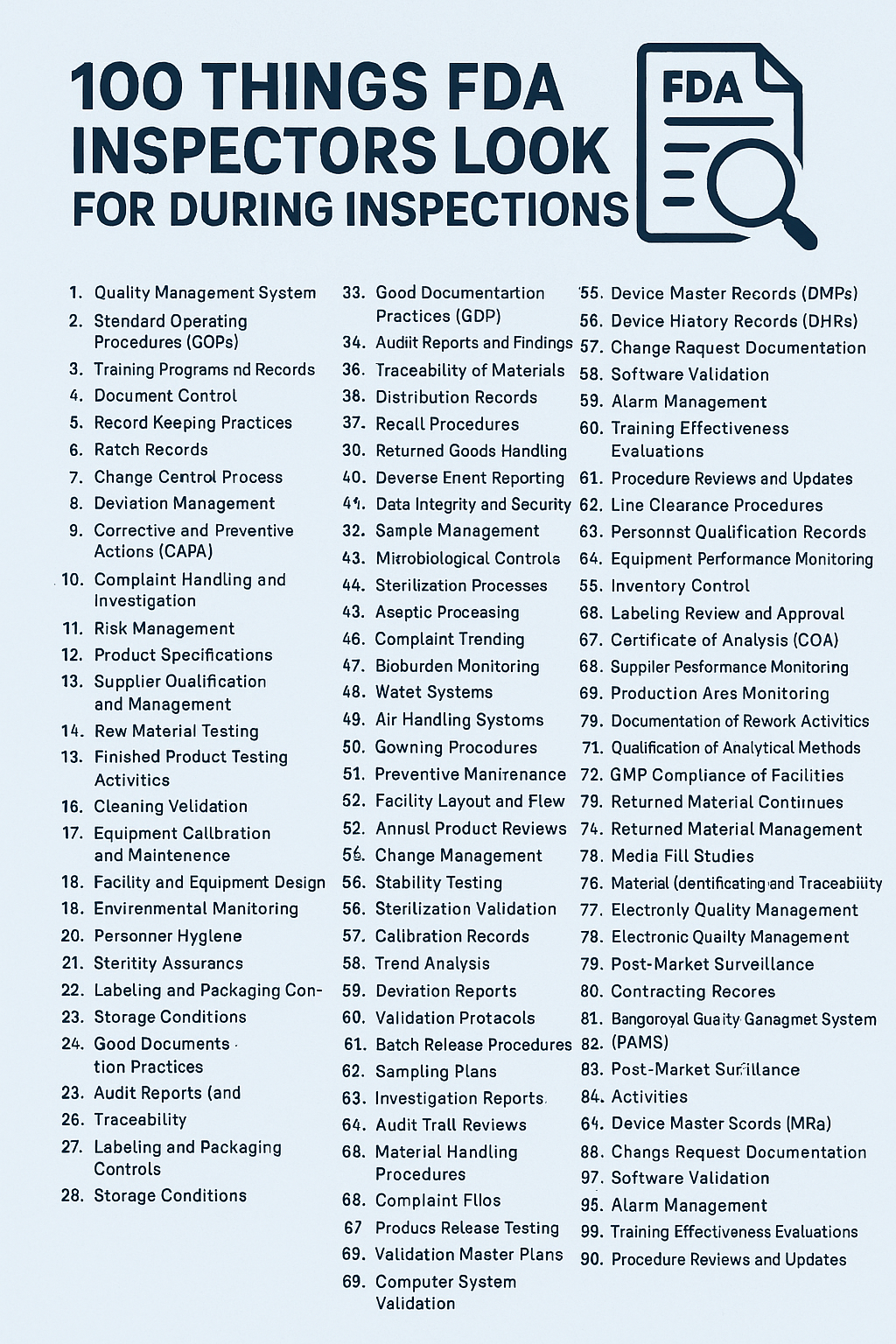tl;dr: FDA inspections are not just regulatory checkpoints but critical evaluations of your quality systems, documentation, and risk posture. Whether it’s a routine inspection, a for-cause audit, or a pre-approval inspection, here are 100 essential elements that FDA inspectors often review in the FDA compliance checklist.

1–20: Data Integrity & Documentation (21 CFR Part 11 and ALCOA+)
- Adherence to ALCOA+ principles
- Accurate and contemporaneous data entries
- Secure and validated electronic systems
- Enabled and traceable audit trails
- Protection against unauthorized data changes
- Version control of forms and templates
- Retention of raw data
- Reconciliation of paper and digital records
- Tampering indicators or suspicious entries
- Backdating or post-dated logs
- Signature authenticity
- Unique user credentials and password policies
- Documentation of data changes
- Use of time-stamped entries
- Traceability of all critical data points
- Access logs and user permissions
- Verification of e-signatures
- System validation protocols
- Gaps in chronological logs
- Duplicated or missing records
21–40: SOPs, Policies & Record Management
- Up-to-date SOPs aligned with operations
- Obsolete SOPs removed from use
- Approval workflows for SOP changes
- Training on new or revised SOPs
- Readily accessible controlled documents
- SOPs covering all critical operations
- Logbooks maintained and up to date
- Indexing and archival practices
- Reconciliation of batch records and SOPs
- Chain of custody logs
- Storage conditions for archived documents
- Document lifecycle management
- Labeling of drafts and final versions
- Change log histories
- Redline tracking during SOP updates
- Procedures for document destruction
- Emergency use document protocols
- Use of master templates
- Defined retention periods
- Controlled document distribution logs
41–60: Training & Staff Qualification
- Role-based training programs
- GCP/GMP/GLP training records
- Qualification of new hires
- Refresher training schedules
- Real-time training status dashboards
- Effectiveness evaluations post-training
- CAPA-based retraining records
- Training on new equipment or procedures
- On-the-job competency assessments
- Documentation of training exemptions
- SOP acknowledgment logs
- Cross-training records
- Documentation of trainers’ qualifications
- Annual training calendar
- Role-specific learning paths
- Language and comprehension checks
- Training deviations
- Tracking of expired qualifications
- Audit readiness training
- Emergency SOP training
61–80: Equipment, Calibration & Facility Maintenance
- Equipment qualification (IQ/OQ/PQ)
- Preventive maintenance logs
- Calibration certificates
- Use of calibrated reference standards
- Validation of cleaning procedures
- Logbooks for usage and downtime
- Environmental control records (temp/humidity)
- Equipment ID and status tagging
- Use of validated software and instruments
- Autoclave performance verification
- Cleanroom pressure differentials
- Filter integrity testing
- Refrigeration logs
- Backup power systems
- Changeover procedures between batches
- Material flow separation
- Routine inspections of facility utilities
- Alarm system tests and logs
- Safety and sanitation checks
- Corrective actions for equipment failures
81–100: Clinical Trial & Product Quality Oversight
- Protocol compliance in clinical trials
- IRB/IEC documentation
- Informed consent recordkeeping
- Drug accountability logs
- Blinding/unblinding documentation
- Subject screening and enrollment logs
- Adverse event documentation
- Serious Adverse Event (SAE) reporting timelines
- Subject withdrawal and follow-up records
- Visit window deviations
- Source data verification
- Investigator site qualification
- Subject inclusion/exclusion compliance
- Randomization code security
- Delegation of authority logs
- Archiving clinical trial master files.
- Inspection readiness plans
- Monitoring visit reports
- Sponsor audit records
- Communication logs between the sponsor, CRO, and site
Why It Matters
Each of these 100 items represents a potential risk point or quality opportunity. Missed documentation, untrained staff, or incomplete CAPAs can lead to Form 483s, Warning Letters, or even clinical holds.
How Atlas Compliance Helps
With tools like Atlas Compliance, teams can:
- Access real-time inspection trends (Form 483s, Warning Letters, EIRs)
- Monitor FDA inspector behavior and issuance rates
- Track and audit CAPAs, SOPs, and training
- Use AI Copilot to surface gaps and suggest improvements
- Stay organized with document control and compliance dashboards
Final Thoughts
FDA inspections aren’t about “getting lucky”—they’re about being ready. Use this checklist to self-audit your processes, plug the gaps, and empower your team to operate with a compliance-first mindset.
If you’re serious about scaling your compliance efforts, modern tools like Atlas can turn inspections from a fear into a formality. For future use, keep this FDA compliance checklist handy.
Good blog post. I absolutely love this site. Keep writing!